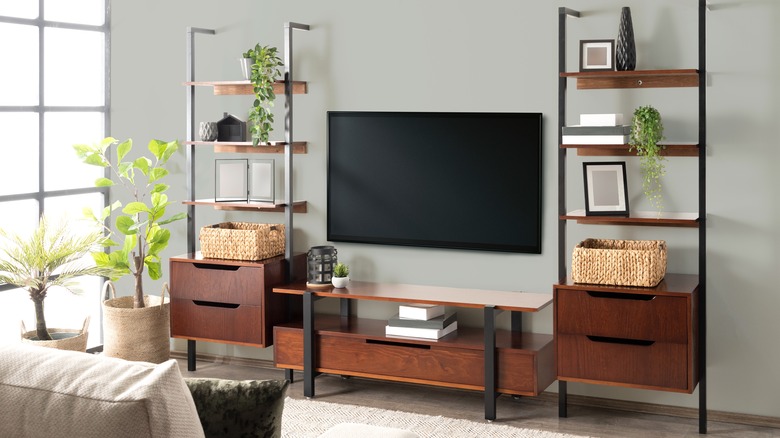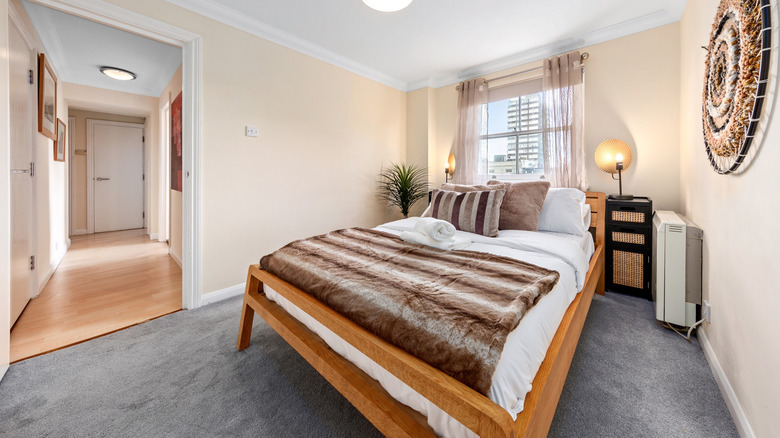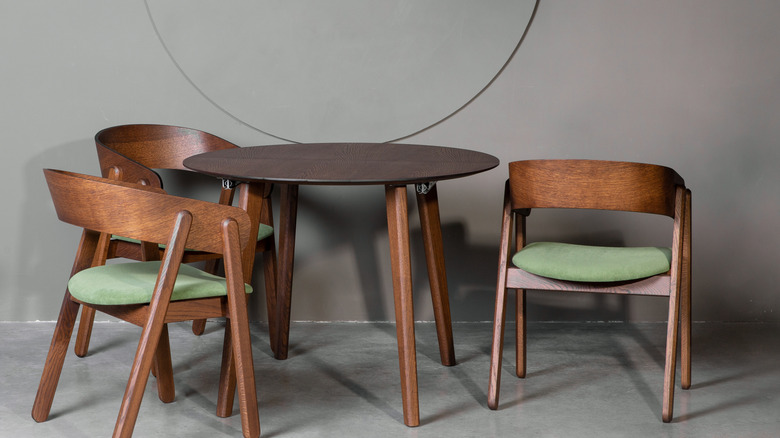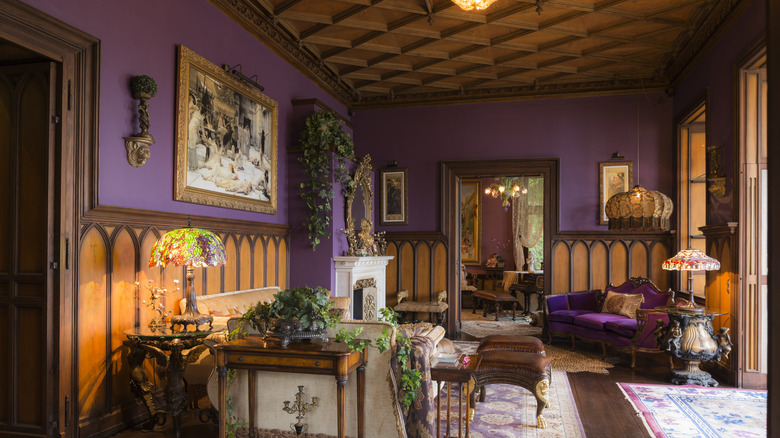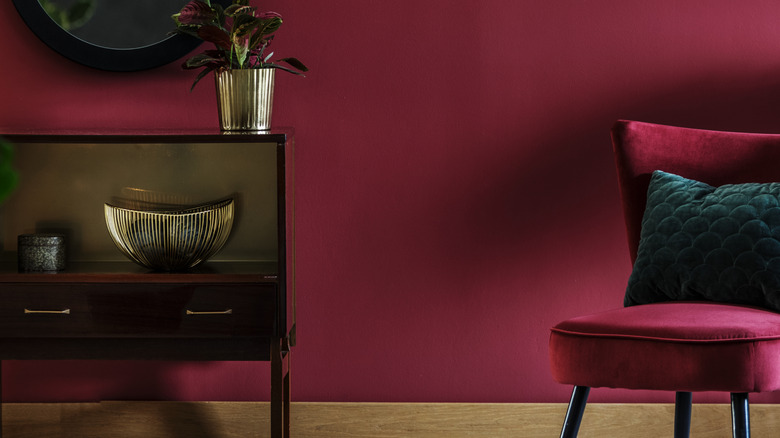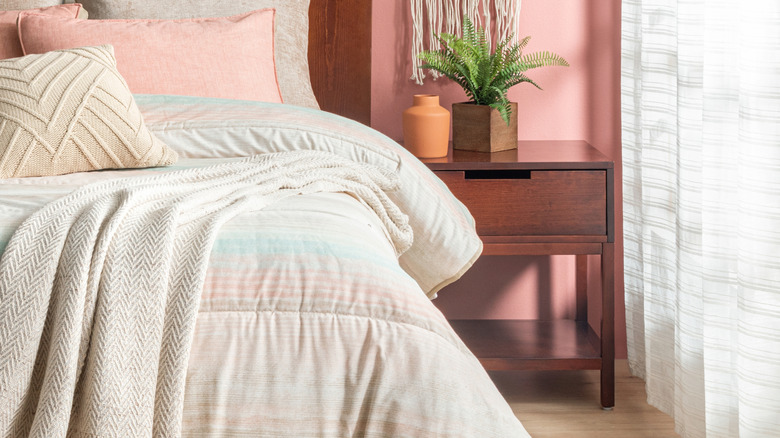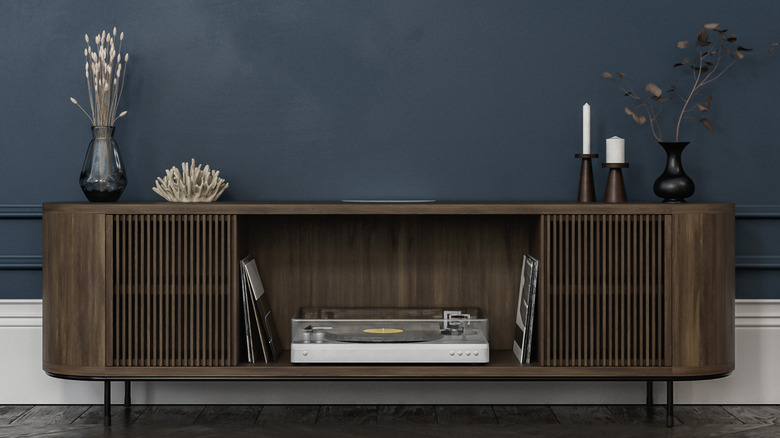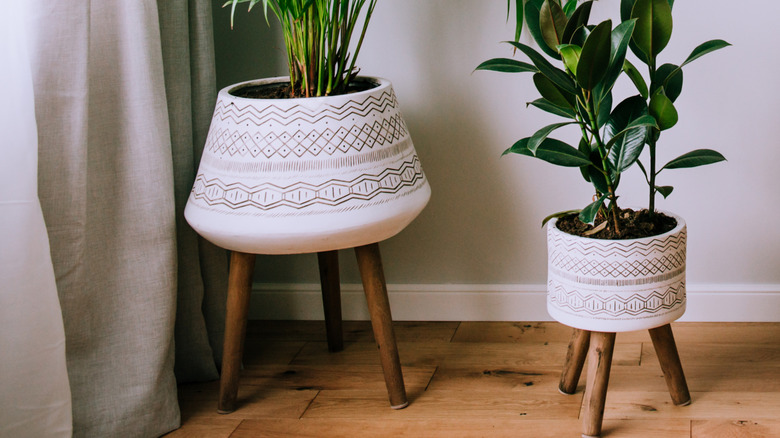20 Best Colors To Pair With Your Dark Wood Furniture
In case you missed it, there's a wood furniture trend that is making a big comeback. It's a fixture of new design styles like grandmillennial. These pieces never went out of style completely — for example, many homeowners proudly display treasured heirloom furniture. Until recently, however, this furniture was thought to date a space. This is especially true when it's used with uncomplementary shades, fixtures, or design styles. Yup, we're talking about dark wood furniture, and it can instantly make any room it's used in feel more sophisticated if paired with the right colors. From classic white to soft neutrals (like beige, eggshell, and ivory) to trending hues like sage green and cerulean blue, there is an array of colors you can consider using on walls, floors, and accents to accompany dark wood furniture.
Are you working with dark wood furniture while remodeling your living room, dining area, main bedroom, or any other room in the house? If it's solid and not stained, this furniture is usually crafted from classic timbers, like mahogany and walnut, or exotic woods, like ebony and rosewood. All of these materials can overwhelm a space if not used carefully. However, get it right, and you can create a cozy or moody — in a good way — vibe. Channel trendy dark cottagecore in your kitchen or something more traditional like Art Deco or Gothic. No matter which style you prefer, to avoid creating a heavy or outdated space, you need to know which colors go well with these classic yet challenging furniture pieces.
Warm white
There's a trendy shade of white you'll want to incorporate in every room if you have dark wood furniture. Warm white creates a soft, inviting backdrop that complements rich-hued materials instead of clashing with them. It also enhances the natural warmth of wood, ensuring your furniture is the focal point of the room while keeping the space light and airy. Plus, even if you use warm white on everything — your walls, ceilings, and trims — it won't make your room feel cold and sterile (like pure white can) due to its subtle yellow or beige undertones.
Taupe
Taupe is a good choice if you want to add a touch of sophistication to your walls without clashing with the deep shades of your wooden furniture. This color bridges the gap between gray and brown. When used as the primary color in a room, it works with both cool and warm palettes, creating a balanced, calming atmosphere. Expert designers swear by taupe for a cozy bedroom for good reason. If you don't want to cover your wall in this color, use it on accents, such as throw pillows, curtains, and area rugs.
Sage green
Since green is the default partner of brown in nature, it makes sense that it would be a good choice for a dark wood furniture-adorned room. Go for sage green on walls: Its muted gray-green tone harmonizes with deep brown cabinets, chairs, and fixtures. It softens the heaviness of dark woods like mahogany or walnut while pairing well with other colors. One handy tip to find the perfect sage green paint color is to hold up a paint swatch against the wall to see how the shade is affected by both natural and artificial lighting inside the room.
Terracotta
Terracotta may be the last color to come to mind as a partner for dark wood furniture. It can be overbearing if used in large doses and is traditionally paired with light wood or used as an accent hue. However, terracotta has a rustic charm that can bring warm energy and a depth of character to a room without challenging furniture in dark shades. Do note, however, that a wall in saturated terracotta works best in spaces with ample lighting. Otherwise, incorporate this color into a dark wood furniture-filled room in small doses: on clay pots, artwork, or cushions.
Gray
Having dark wood furniture is tricky. It doesn't just make a space feel smaller; it automatically draws the eye, leaving little room for other elements to shine. Sometimes you just have to fight fire with fire for favorable results. Take, for instance, pairing gray with dark wood. Gray offers a sleek and modern contrast to brown materials. At the same time, it allows the dark wood shades to stand out. For something sleek and contemporary, try gray-painted dining room walls and polished concrete floors with mid-century modern dark wood dining furniture.
Classic white
This list wouldn't be complete without classic white. It's a traditional pairing for dark wood furniture, offering a crisp contrast that never dates. This clean, neutral hue enhances the natural beauty of dark wood, bringing out black or red notes. It makes the furniture the main attraction and reflects light brilliantly, helping dark pieces feel less heavy. Just be sure to avoid the white paint mistake that ruins low-light rooms, or you run the risk of making a room feel cold. Also, don't forget to add soft textures or metallic accents to complete the high-end, polished look.
Ghost white
Ghost white, a subtle off-white with faint blue or gray undertones, cools a room filled with dark wood furniture. It has the crisp, airy feel of classic white without the starkness. It's a white and wood trick designers swear by for a timeless look. Since ghost white's delicate hue greatly enhances the contrast between the walls and your furniture, your eyes are drawn to the wood's rich patterns. If you can, incorporate navy blue or soft pastels like lavender or pale turquoise for a fresh, elevated aesthetic that feels effortlessly elegant.
Beige
Beige brings calmness, warmth, and harmony to a room filled with dark wood materials. It typically has soft and sandy tones that can highlight the richness of darker woods without creating visual heaviness. When used on walls, beige offers a cozy, welcoming atmosphere that blends seamlessly with both traditional and contemporary décor. It readily complements earthy textures, like linen, wool, or rattan — use these materials to complement organic wooden furniture. Lastly, this color's versatility makes it easy to layer with whites, browns, and greens for a cohesive look that feels timeless yet delightful.
Cerulean blue
Another option to consider is cerulean blue. It offers a refreshing pop of color that pairs beautifully with the warm dark wood, especially when the furniture is adorned with crisp white trims or metallic — gold or brass — accents. This vivid yet soothing shade evokes the sky and sea, bringing a touch of nature into your space. Cerulean blue contrasts strikingly with the natural depth of dark wood without overwhelming a classic or modern design aesthetic. Try this blue in living rooms or bedrooms with a boho, rustic, or coastal aesthetic.
Eggshell
Eggshell is a soft, creamy neutral that's a good match for dark wood furniture. The subtle shade reflects light beautifully, contrasting gently with deep timber tones. On walls, eggshell paint can bring a crispness and inviting glow that enhances the richness of dark walnut, mahogany, or espresso finishes. It's ideal for cozy living rooms or bedrooms. When paired with woven textures, soft fabrics, and warm lighting, eggshell can help dark wood feel timeless and elegant.
Purple
Purple in all shades can add refinement to any room filled with classic dark wood furniture. The cool undertones of the color create a soothing balance against the warmth of the wood, while pastel, gently floral undertones keep the space from feeling too heavy. You'll want to use royal shades of purple paint in your home if you have dark wood furniture — violet, grape, plum, amethyst, eggplant, and wine all enhance the wood's natural grain. Pair the wood and purple combination with metallic or gloss accents and ivory textiles.
Warm ivory
Warm ivory provides the perfect middle ground between pure white and beige or yellow. It offers a creamy richness that complements dark wood furniture beautifully and enhances natural light, keeping the overall space bright. It's particularly flattering in transitional or practical spaces, like home offices and kitchens, where you want a calming color that keeps visual distractions to a minimum. Decorate with soft pastel accents, natural décor, and vintage finds for a very luxe yet inviting look.
Wine red
Red paint shades add a passionate pop of color to any room, and wine red is no different. What's more, this hue contrasts dramatically with dark wood cabinetry and furniture. Its rich, velvety tone echoes the hints of red in mahogany or cherry timber, creating a cohesive look. One thing to note about this color is that it makes a bold statement. Like other dark reds, wine red evokes elegance, passion, and energy. It's better used on an accent wall in a dining room or living room than in a bedroom. To keep things balanced, adorn your dark wood furniture with faux velvet, gold, or brass accessories that won't overwhelm the space.
Dark green
Dark green is one of the best green colors for a vibrant home. It's grounding and organic, and it pairs seamlessly with dark wood furniture. Since its earthy tones echo those found in nature, it creates a woodland-like ambience in any room. Deep forest or olive greens complement the dark wood best. The result is a cozy yet refined space that feels timeless and connected to the outdoors. Layer marble and brass accents with leather or natural fiber fabrics to create a space that's naturally luxurious — perfect for living rooms, studies, or formal dining areas.
Blush pink
Blush pink provides a romantic contrast to bold dark furniture. It's light and charming, so you can pretty up any room with perfectly pink paint ideas, even if it's filled with heavy timber accessories. Use blush pink on your walls to introduce a pop of color or use it for chair upholstery or paint it inside the shelves of a wooden bookshelf. The blush pink and dark wood pairing works especially well in bedrooms or living spaces where you want a romantic touch. Complement the combination with warm lighting and natural textiles like linen.
Deep blue
With its rich, moody undertones simultaneously bringing drama and refinement, deep blue is a striking companion to dark wood furniture. It's a cool color, so it offsets the sometimes overwhelming warmth of dark wood while amplifying the grain patterns, especially in reclaimed timber furniture. The pairing works well in both traditional and modern interiors accented with gold, brass, or white. While light blue is the new neutral for timeless kitchens, deep blue is ideal for offices, dining rooms, or living rooms as it gives off a sense of security.
Charcoal
Charcoal is a moody exterior color that's trending right now, and it can work equally as well indoors on accent walls or even ceilings. This deep gray-black hue creates a dramatic ambiance in a room that contrasts exceptionally well with the natural warmth of dark wood furniture. Interestingly, the charcoal-dark wood pairing doesn't make a room feel small if you balance the depth with lots of natural light and light-hued textiles and accents. In fact, this results in a polished, contemporary look.
Pistachio
Pistachio green, with its muted freshness, is an unexpected yet delightful pairing with dark wood furniture, especially walnut. Its pastel undertones lighten a dark space, and the color adds a touch of nature's serenity. The hue is an excellent choice for kitchens, bedrooms, or creative spaces, where pistachio-painted walls contrast brightly with dark timber, preventing the room from feeling too heavy. The hue's organic vibes enhance rather than hide unique wood patterns.
Lilac
Lilac provides a dreamy, uplifting vibe that complements the depth of dark wood cabinetry and furniture. It's a cool purple that's light enough to make wood pieces really stand out. Lilac adds softness and openness to a space, so it is ideal for bedrooms, living rooms, and entryways on the smaller side. It works wonderfully with gold- and silver-trimmed furniture pieces paired with natural textiles like linen and cotton and foliage-focused houseplants growing in tall pots with dark wood legs. The result is a refreshing space that feels light yet full of character.
Wood on wood
Setting dark wood furniture in a room with wood walls, trim, and more creates a rich, layered aesthetic. However, to pull this look off, you need to master the art of contrast. Light hardwood floors, walls, or paneling highlight the craftsmanship of dark wood furniture — for example, cherry and aspen work well together. Alternatively, putting different dark wood species together highlights subtle distinctions in grain pattern and color. Either combination will transform any room into a nature-inspired retreat. Don't be afraid to mix finishes, like matte raw wood and glossy lacquer, as this will add visual interest.
